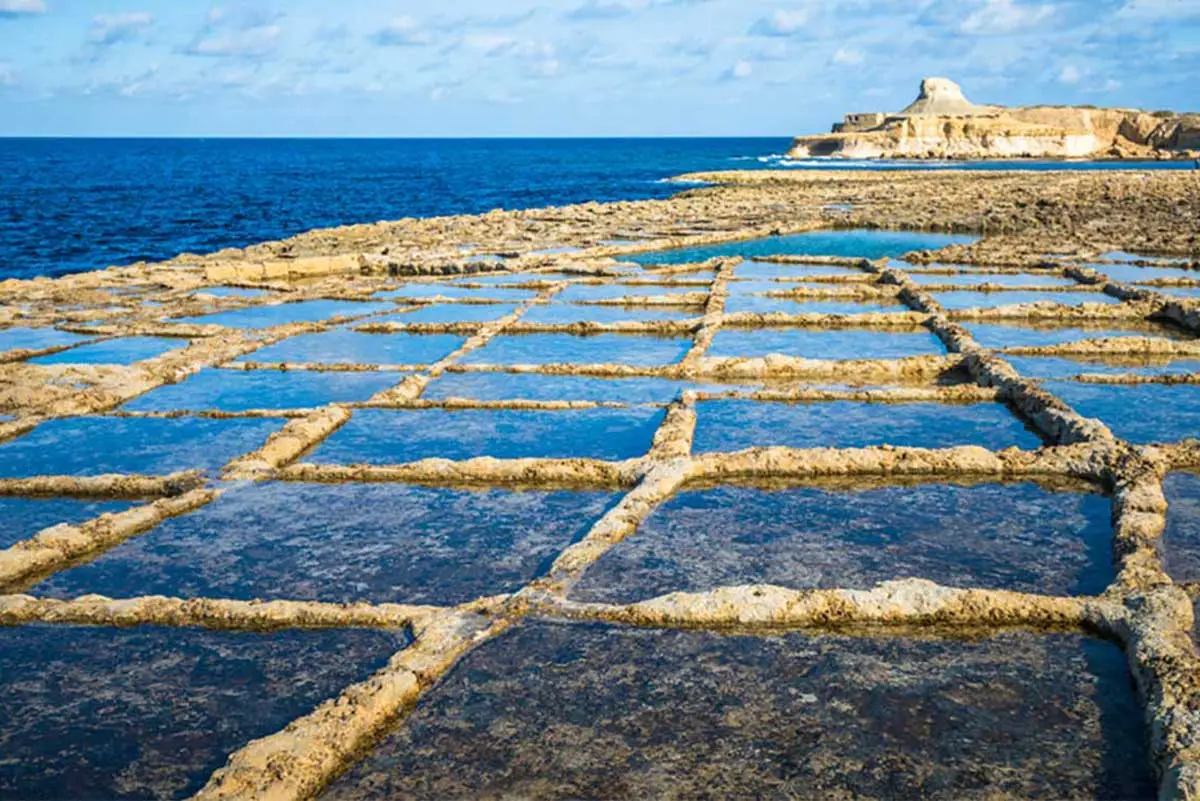The philosopher Pythagoras once wrote: ‘Salt is born of the purest parents: the sun and the sea.’ Salt is a natural life sustaining mineral and one of our oldest forms of food seasonings and preservatives.
Winding our way north along Gozo’s coastline we turned a corner and collectively drew in our breath at an eerily beautiful sight. Amid mounds of perfectly sculpted sand on the sea’s edge was what appeared to be another window of sorts. Lying side by side and row by row were liquid panes of a glass-like surface, disjointedly mirroring the clouds above.
We were witnessing an Xwejni Bay tradition: the Gozo salt pans. On a two-acre stretch of shore outside the tiny resort town of Marsalforn, there are about 300 salt pans, from which eight families harvest the mineral from the sea.
The Saltpans in Gozo’s northerly coast just up from Marsalforn are a transfixing landmark and of vital importance, upholding an ancient trade and skill, whilst harvesting one of Gozo’s important natural raw materials – Salt.
The ancient Romans began the salt pans of Marsalforn over 2,000 years ago, and the process is still being done to this day. Sea salt is coarser than refined salt and is a staple in Mediterranean gastronomic traditions. Ironically, it is not considered to be as salty-tasting as its refined or iodized counterparts.
If there is one thing the Maltese do have, it’s an endless supply of sea salt, but it does not end up in your salt shaker by accident. Salt panning involves carving shallow niches into rock by the sea and pumping them regularly with seawater. The stagnant seawater is then left to evaporate in the sun. What gets left behind is the final product- rock salt. It is a natural process that yields a versatile cooking ingredient. The Marsalforn salt pans are a fascinating display of ancient ingenuity still being used today.
The Cini family’s ancestors have worked the Xwejni Salt Pans since the 1860s. Josephine Xuereb is a 5th generation salt-farmer continuing the family tradition of her mother Rosa’s family. Her family are synonymous with salt. In Gozo, the process of making artisan salt through evaporation goes back to Phoenician and Roman times. During the British occupation of Gozo salt-harvesting was revived when the Government offered concessions for local people to work them and share-own them.
Josephine says: “My father Manuel is known all over the world as ‘Leli Tal-Melh’ which means Manuel The Salt Man. He’s been making salt since 1969, when he married my mother Rosa and they revived her family’s business. Salt harvesting then was dying out because it is physically very hard, back-breaking work. But after my mother met my father, she taught him the trade – they fell in love, they fell in love with the salt pans and the rest is history. Today, 50 years later they are both still harvesting salt. The salt preserved their love and preserved the local trade as well.”
“Our salt is mainly distributed in supermarkets, greengrocers, and vegetable vendors,’’ she said. “But we have other customers who come directly to us, especially those preserving capers, local olives, and for cottage cheese. It’s perfectly ideal for cooking as it dissolves quickly and leaves the perfect taste.’’
Emmanuel Cini, Xuereb’s father, is also known as Leli tal-melh, Leli for short. “Melh’’ means “salt’’ in Maltese.
“Every morning I am eager to go down to the salt pans,’’ Cini said. “As soon as I start down the steep road and get a glimpse of them from the top of the cliff, I am fulfilled. At sunrise, the pans compare with a piece of woven lace, particularly when the first salt crystals start to appear.
“During the harvest season I am always attentive for the weather forecast,’’ he continued. “Throughout 40 years in this trade, I learned from my mistakes. As soon as it is ready to be collected, I make sure to sweep it. There have been occasions when the white crystal salt is collected in a large heap and the wind suddenly changes from the south, bringing dust and sand. That white heap is changed to yellow as it’s covered with a layer of dust – too much work in vain.’’
Xwejni’s Salt Pans chequerboard pattern and shimmering mirrored reflective pools are always a dynamic sight to behold. Spanning several kilometres across Gozo’s northern coast. Today they are divided between 3 salt farmers. The intricate formation of shallow square pools and larger feeder pools, which Josephine compares to delicate ‘lacework’ use 3 raw natural ingredients: the sun, sea and wind to create this essential mineral for life.



